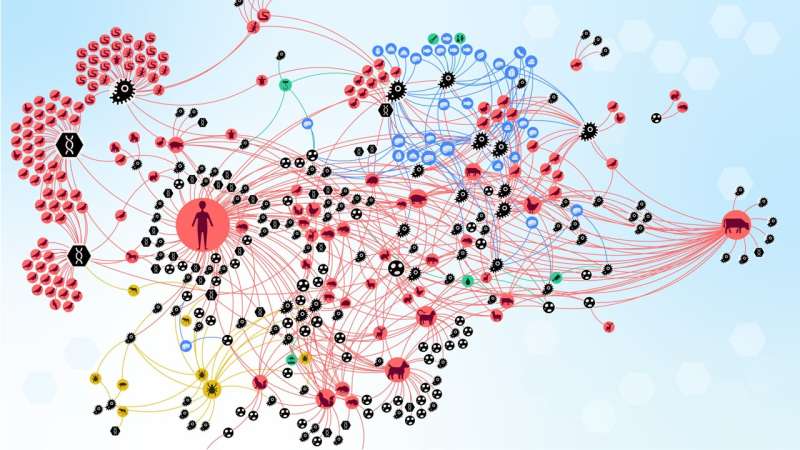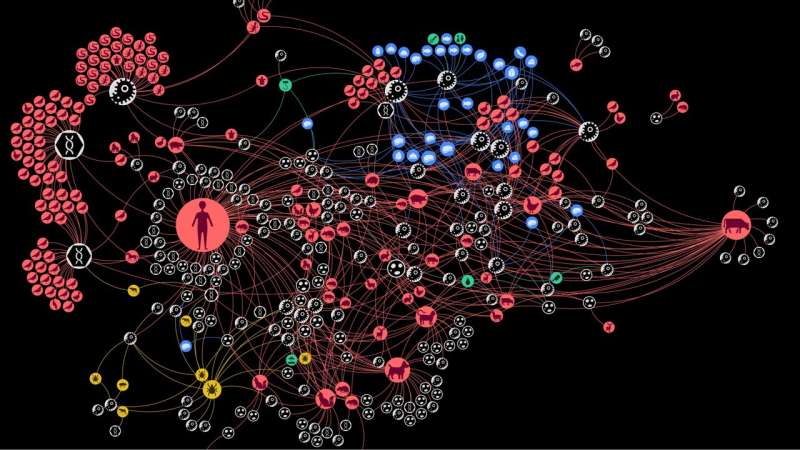
This visualization provides a comprehensive picture of natural zoonotic interactions in Austria and offers valuable epidemiological insights. In the zoonotic network in Austria, each node (circle) represents an actor in the zoonotic network. Credit: Complexity Science Hub
Researchers from the Complexity Science Hub and the University of Veterinary Medicine Vienna have dissected the complex interactions involved in zoonoses, which affect more than two billion people worldwide each year. They introduce the concept of a “zoonotic network”, a detailed network representation of the relationships between zoonotic agents, their hosts, vectors, food sources and the environment.
The study “A One Health Framework for Exploring Zoonotic Interactions: A Case Study” was published in Nature Communications.
“Zoonotic diseases, which can be transmitted between animals and humans, are a significant public health problem, and our study highlights the importance of a holistic approach to understanding and managing these risks,” explains epidemiologist and CSH researcher Amélie Desvars-Larrive.
Transmission context
Transmission of zoonoses to humans can occur through direct contact with saliva, blood, urine or even feces of infected animals. For example, a bite (for rabies), a scratch (for cat scratch disease) or skin contact (for skin fungi).
Indirect transmission can also occur through bites from arthropod vectors (as in the case of West Nile virus and tick-borne encephalitis) or through contact with contaminated objects, environments or surfaces.
“For example, the food and water we consume can be potential infection routes for zoonoses,” adds Desvars-Larrive, also an associate professor at the University of Veterinary Medicine Vienna (Vetmeduni).
More than just a host-pathogen interaction
“Zoonotic diseases are often discussed in terms of host-pathogen interactions. Understanding the complex animal-human-environment interface remains a major challenge,” explains the epidemiologist.
“As co-author Anja Joachim pointed out, simply studying the presence of a parasite in cat feces, such as Toxoplasma, does not tell the whole story. Is it the cat-environment, environment-human or cat-human interface? The concept of ‘interface’ remained unclear. This prompted us to develop a new approach to zoonoses and demonstrate it through a case study,” adds Desvars-Larrive.
“We wanted to develop a method to study the interfaces where the exchange of circulating zoonotic pathogens takes place. This goes beyond host-pathogen interactions to take into account other sources of infection, such as a contaminated environment, for example a sandbox, or contaminated food, which are often neglected when modeling the dynamics of zoonotic diseases.”
Austrian data covering almost 50 years
The researchers first conducted a systematic literature search for all documented interactions between zoonotic sources and pathogens in Austria between 1975 and 2022. From this, they created the “zoonotic network”. The results of the analysis were finally prepared in a dashboard by CSH data visualization expert Liuhuaying Yang.
The team identified six distinct communities sharing zoonotic agents in Austria, influenced by closely related infectious agents, proximity to humans and human activities. The community comprising humans, the oldest domesticated species (including dogs, cats, sheep, cattle and pigs) and species that have adapted to live with humans (e.g. the house mouse) shares the most zoonotic agents, the study found.
The results also highlight the important role played by certain animals, such as wild boar, dogs, domestic cats, yellow-necked mice or raccoon dogs, and arthropods, particularly ticks, in “bridging” host communities.
“Knowing which actors in the network are more influential than others can be very useful in zoonotic disease surveillance programs, for example, because they could serve as sentinels to monitor the circulation of zoonotic agents,” says Desvars-Larrive.

This visualization provides a comprehensive picture of natural zoonotic interactions in Austria and offers valuable epidemiological insights. In the zoonotic network in Austria, each node (circle) represents an actor in the zoonotic network. Credit: Complexity Science Hub
A quantitative approach to One Health
One of the key challenges for the One Health community is to quantify interactions and risks at the human-animal-environment interface. The One Health approach recognizes that the health of humans, domestic and wild animals, plants, and the broader environment are closely linked and interdependent.
Using a quantitative approach based on the One Health concept and specific structures within the network, the study confirms that in Austria, zoonotic transmissions are more likely to occur at the human-livestock and human-food interfaces. “Consumption of contaminated food poses a major risk for human zoonotic infection, with Listeria, Salmonella and Escherichia being the most frequently reported agents in our study,” says Desvars-Larrive.
Public awareness
“With our interactive map, we also want to arouse curiosity and educate people,” adds the epidemiologist. “We all come into contact with pathogens, but only a few of them cause illness, so we don’t have to worry too much. But it is important to develop some awareness, for example by cleaning your knife between meals to avoid cross-contamination.”
“If you have been bitten by a tick, you must be vigilant in the days or even weeks that follow, because ticks transmit a whole series of diseases to humans and animals, which are often difficult to diagnose because the symptoms may not appear until weeks later,” explains Ms. Desvars-Larrive.
More information:
A One Health framework for exploring zoonotic interactions demonstrated through a case study, Nature Communications (2024). DOI: 10.1038/s41467-024-49967-7
Provided by Complexity Science Hub Vienna
Quote:Study reveals complexity of zoonotic transmission chains (July 15, 2024) retrieved July 15, 2024 from https://phys.org/news/2024-07-unveils-complexity-zoonotic-transmission-chains.html
This document is subject to copyright. Apart from any fair dealing for the purpose of private study or research, no part may be reproduced without written permission. The content is provided for informational purposes only.